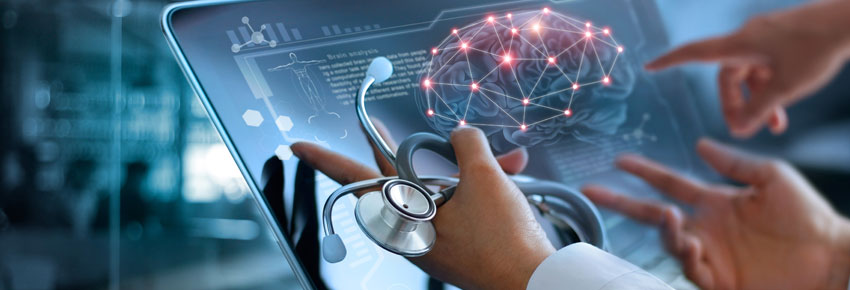Healthcare 4.0: Five Trends You Need to Know
Fév 19, 2021 | 42Gears Team

Introduction
New technology in healthcare emerges all the time – so why is healthcare 4.0 so exciting? In the same vein as concepts like industry 4.0 and logistics 4.0, emerging technology in healthcare 4.0 is interconnected in ways never seen before. This enables all sorts of exciting improvements to patient care.
Healthcare 4.0 allows doctors and patients to access more information in less time. In turn, they can make more informed decisions and have a higher quality-of-life. Let’s review five of the most promising changes that healthcare 4.0 brings to the medical industry.
1. Making Healthcare More Responsive Through Connected Devices
Healthcare 4.0 relies on a network of sensors, monitors, and other healthcare technologies that constantly talk to each other. The term Internet of Things (IoT) is popular in the context of consumer electronics, and it also applies to healthcare. However, in the context of hospitals, experts use the term Internet of Medical Things (or IoMT) instead.
Creating a network of connected devices allows medical procedures to evolve in novel ways. For instance, the da Vinci surgical system allows doctors to remotely perform operations using a precision-instrument system. This ensures surgeries remain consistently high-quality between surgeons.
Wearable technologies play an essential role in recording and transmitting patient data, though their role doesn’t end there. They can be valuable for ensuring worker safety as well. Companies such as SmartCap provide monitoring technologies to track worker awareness, preventing workers from sleeping at work. Although not yet applied to hospitals, it is easy to see how this could benefit healthcare workers.
2. Reaching New Worlds With Virtual Reality
It would impossible to discuss new and emerging technology in healthcare without mentioning virtual reality (VR). By means of wearing a VR headset, patients can enter new realms and escape the monotonous hospital landscape for a short period of time. That said, VR technology and healthcare interact in other ways as well.
Beyond simple escapism, VR has been shown to have effective pain-relief capabilities for some patients, such as burn victims. This could be a useful way to improve patient outcomes when learning to manage chronic pain. VR headsets are now compact enough to bring home, giving patients a new pain-relief strategy once they leave the hospital.
VR can also be useful for training doctors on new surgical procedures. This technology enables doctors to learn new information risk-free. After all, there are no consequences for making mistakes in virtual surgery.
3. Providing New Resources Via AI
As artificial intelligence (AI) becomes more and more advanced, it can play an increasingly large role in keeping patients safe and happy. This frees personnel to focus on the more technical elements of high-quality patient care, without neglecting patient needs.
The chatbot is one form of AI that is already making an impact in patient care. By helping patients answer screening questions efficiently and courteously, chatbots provide a consistent positive experience for all new patients. Chatbots may even be able to provide some kinds of mental health therapy. While they are not replacements for professional help, chatbots can help users decide what kind of help they need.
In the future, social companion robots may also become a major presence in patients’ lives. They can serve as hospital receptionists, or even take on some duties from caretakers. One robot that helps lift patients into wheelchairs takes the form of a giant lovable bear!
4. Elevating the Hospital Dining Experience
Almost everyone who spends time in a hospital has one thing in common: the need to eat. As such, it is frustrating that many dislike hospital food and dread mealtimes as a result. Thanks to new technologies, however, hospitals may be able to quickly improve what and how patients eat, and how they eat it.
Many hospitals have begun to grow produce to create fresh meals for their patients, with a strong emphasis on plants in place of meat. While this can be logistically complex, IoT technologies are hugely useful in agriculture. For example, hospitals can use IoT devices to automate greenhouse operations. This would let them benefit from fresh produce without the high cost of hiring a full gardening crew.
Technology can also help by enabling interactive « room service » dining for patients. So-called « smart hotels » allow guests to order food from touchscreens, and hospitals could integrate this technology as well to improve efficiency.
5. Rethinking the physical hospital space
Doctors can now obtain detailed patient information remotely, thanks to wearables and other IoMT devices. As a result, healthcare facilities may no longer need physical spaces for standard procedures like routine check-ups. Therefore, the industry can rethink what it means to build and operate a hospital. In fact, this has already led to some very intriguing ideas.
The world’s first purely telehealth-focused facility, Mercy Virtual Care Center, is remarkable for the way it approaches patient care. Even though the facility is quite large, there are no patients. Instead, the facility serves as a giant remote dispatch center, connecting doctors and medical staff with remote patients who need help.
Smart kiosks can also play a major role in streamlining healthcare, as shown by healthcare firm Higi and its huge fleet of health-monitoring kiosks. Since kiosks can include a large number of healthcare monitoring systems in a small footprint, they can serve as convenient health-monitoring stations. This is especially important for those who cannot afford personal health-monitoring devices.
Conclusion
While all of these innovations are very exciting, there is one major challenge connecting them. Namely, remotely managing all the devices needed for healthcare 4.0 can be hard.
This is where mobile device management (MDM) technology can help. SureMDM by 42Gears is an MDM solution that can manage all kinds of devices from a single central console. Whether hospitals need to manage wearables, VR headsets, patient tablets, or smart kiosks, SureMDM keeps every device safe. Plus, if you’re interested in SureMDM, you can try it free for a month at any time.
Embrace Healthcare 4.0 with SureMDM
Subscribe for our free newsletter
